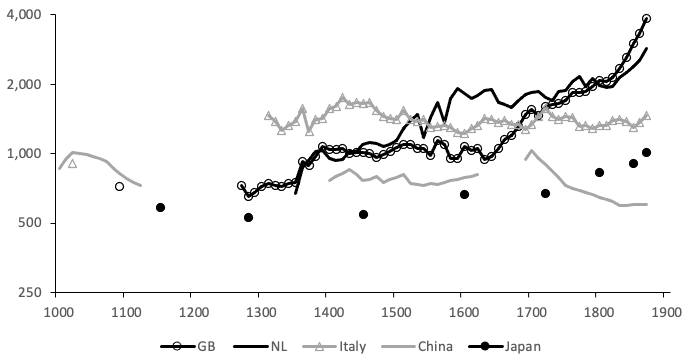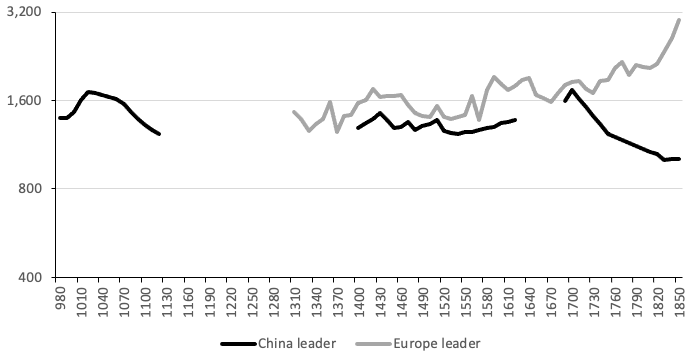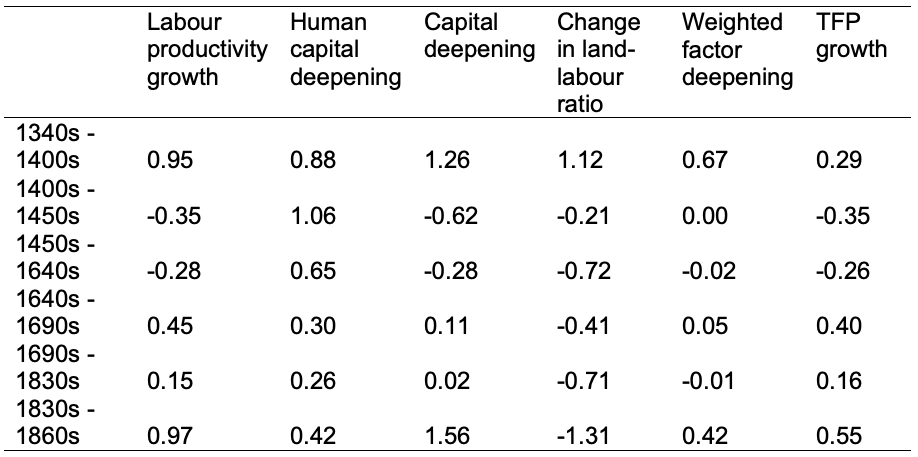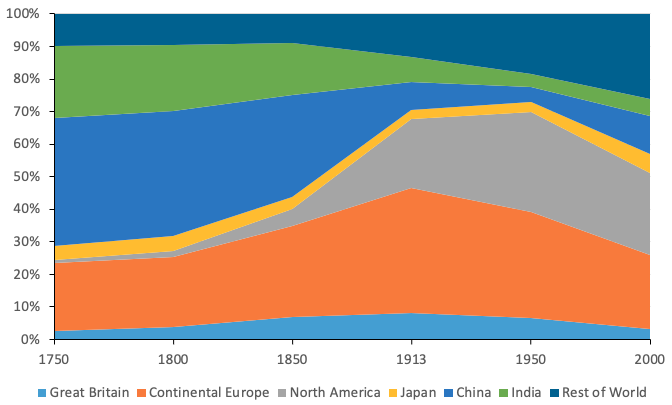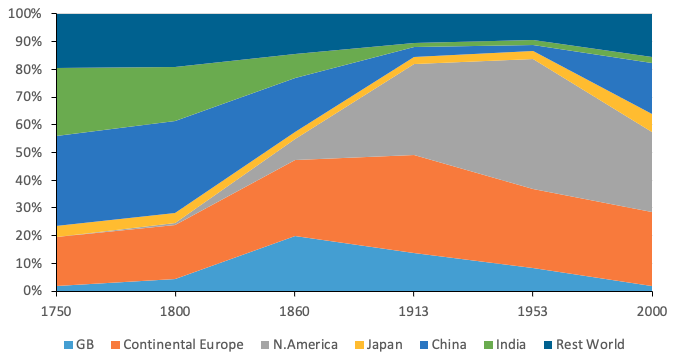The debate over the Great Divergence in productivity and living standards between Europe and Asia has had a remarkable impact on our understanding of the sources of western prosperity. For much of the 20th century, economic historians treated the Industrial Revolution as the culmination of a process of gradual improvement, beginning in the Late Middle Ages and continuing through the early modern period (Weber 1930, Landes 1969). As Europe transformed its institutions and accumulated capital, Asia stagnated and began to fall behind. The Industrial Revolution and 19th century colonialism were seen as accelerating this process of divergence, rather than regarded as its fundamental causes. Pomeranz (2000) questioned what he saw as the Eurocentric bias of this account, claiming that as late as 1800, the Yangzi Delta region of China was as developed as Britain and the Netherlands, the richest parts of Europe. Other parts of Asia were also characterised as equally developed at the end of the 18th century.
However, despite the fundamentally quantitative nature of the revisionist claims being made, this work was not generally based on systematic analysis of data. Whilst this was understandable given the past focus of quantitative economic history on the modern period, and particularly the period since the mid-19th century, the new century has seen much progress in the extension of the quantitative approach both back in time and across space to cover Asia as well as Europe, and this paper draws on this work to provide an account of the Great Divergence. The word “accounting” is used here in two ways, embracing both measurement and explanation.
In a new paper (Broadberry, 2021) I argue that the revisionist authors of the California School were right to point to regional variation in economic performance in both Europe and Asia, but went too far in claiming parity of economic performance between the two continents until the 19th century. New historical national accounting data suggest that the Great Divergence dates from the 18th rather than the 19th century, a view that has recently been endorsed by Pomeranz (2011, 2017). However, this is obviously a lot later than suggested in the traditional view, where Europe was seen as forging ahead since the medieval period.
The new estimates of GDP per capita for three leading nations in Europe and two in Asia are graphed in Figure 1, and point to substantial regional variation in both continents. First, there was a European Little Divergence, as Britain and the Netherlands overtook Italy. Starting out from a lower level of GDP per capita, both Britain and the Netherlands received a permanent boost to per capita incomes after the Black Death of the mid-14th century, and the Netherlands forged ahead of Italy in the 16th century during its Golden Age, while Britain overtook Italy in the early 18th century and the Netherlands at the beginning of the 19th century. Second, there was an Asian Little Divergence as Japan overtook China. Japan forged ahead of China during the 18th century, but continued to grow more slowly than Britain, which emerged as the leading Eurasian nation of the 19th century (Bassino et al. 2015).
Figure 1 GDP per capita in Europe and Asia, 1000-1870 (1990 international dollars)
If attention is restricted to large Asian states such as China and Japan, then it would appear that the Great Divergence had already occurred by 1400, when the leading Asian state (China) was already substantially poorer than the three leading European countries (Italy, Britain, and the Netherlands). However, China was dramatically larger than any individual European country. Chinese population in 1600 was 160 million, compared with 13.1 million in Italy, 4.2 million in Britain and just 1.5 million in the Netherlands (Maddison 2010). While the GDP per capita gap between the leading European nations and China remained small, as it did until the 18th century, smaller Chinese regions such as the Yangzi delta, which were of comparable size to European countries, may still have been on a par with the richest parts of Europe.
Figure 2 GDP per capita in the leading regions of Europe and China, 1000-1870 (1990 international dollars)
Figure 2 charts the level of GDP per capita in the leading Chinese and European regions. The China leader series is for the Yangzi delta, while the Europe leader series is based on Italy until 1540, followed by the Netherlands until 1800 and then Great Britain. On this basis, it is clear that a significant gap opened up between the leading regions of Europe and Asia only after 1700.
As well as quantifying the timing of the Great Divergence in terms of GDP per capita comparisons, I also offer an account of the Great Divergence, in the sense of explanation. Drawing on Maddison’s (1988) distinction between proximate and ultimate sources of growth, the first step is to assess the contributions of the proximate factors. These include the growth of the labour force, increased labour effort, more cultivated land, investment in both human capital and physical capital, the growth of total factor productivity (TFP) and structural change. A major hurdle to conducting growth accounting exercises over the long period considered here is the lack of data on the capital stock. Here I draw on a recent study by Broadberry and de Pleijt (2021), which estimates investment and the capital stock for Britain over the period 1270-1870. This helps to shed light on how Britain went from being an economic backwater of Europe in the 14th century to world GDP per capita leader by the beginning of the 19th century. Based on the work of Solow (1957), growth accounts in intensive form explain the growth of labour productivity in terms of human capital deepening, capital deepening, changes in the land-labour ratio and growing efficiency.
The results in Table 1 show that the growth of labour productivity was driven predominantly by improved efficiency, or the growth of TFP. Note that weighted factor deepening is the weighted sum of human capital deepening, capital deepening and changes in the land-labour ratio, which was more important than TFP growth only during the second half of the 14th century, in the aftermath of the Black Death. Similar findings are available from the growth accounts presented by van Zanden and van Leeuwen (2012) for the Netherlands over the period 1540-1800. To adapt the pithy phrase that McCloskey (1981: 108) applied to the Industrial Revolution, we may say that ingenuity rather than abstention governed the Great Divergence, which was due to more efficient use of factor inputs rather than savings channelled into equipping people with more factor inputs.
Table 1 Accounting for the growth of British labour productivity, 1340s to 1860s (% per annum)
Notes: Factor weights are 0.4 for labour, 0.2 for human capital, 0.3 for capital and 0.1 for land.
Turning to ultimate sources, I begin with institutions. State institutions were important in explaining the patterns of divergence within Europe and Asia as well as between the two continents. In the Netherlands and Britain, state capacity was able to expand, as can be seen in the per capita fiscal revenue data in Table 2. At the same time, however, merchants were able to exercise control over the state through parliamentary activity (van Zanden et al. 2012, Henriques and Palma 2019). This meant that the state was able to create the right incentives for accumulation and innovation that underpinned the growth of labour, human and physical capital, cultivated land, and TFP.
Table 2 Per capita fiscal revenues, 1500/09 to 1780/89 (grammes of silver)
However, it would be difficult to understand the Great Divergence without reference to both first and second nature geography, the other fundamental source of growth. Krugman and Venables (1995) showed how exogenously given first-nature advantages or disadvantages become amplified rather than reduced by forces of economic integration. Favourable locations with high productivity are seen as attracting people and investment, which further raises productivity due to the benefits of agglomeration. Unfavourable locations with low productivity attract fewer people and investment, thus falling further behind. Reductions in the cost of trade may thus have asymmetric effects on different regions, with industry clustering in a few favourable locations as markets become more integrated rather than being dispersed evenly around the world.
Crafts and Venables (2003) show how industrial production became much more concentrated than overall economic activity in core regions as transport costs fell and the world became much more integrated from the 18th century. In the top panel of Figure 3, their approach has been extended back to 1300 using the new historical national accounting data to reconstruct shares in world GDP. This shows that although there were noticeable changes in world GDP shares in the 14th and 17th centuries, they were small relative to the changes from the 18th century. The middle and bottom panels of Figure 3 focus on the period since 1750 and show how both GDP and industrial production became more concentrated in Britain, Europe, and North America and also how the process of concentration went much further in industrial production.
Figure 3 Regions’ shares in world GDP and world industrial production (%)
A. Shares in world GDP, 1300-1870
B. Shares in world GDP, 1750-2000
C. Shares in world industrial production, 1750-2000
This illustrates the importance of second nature geography. As transport costs fell and the world became more integrated, it became profitable for industrialists to concentrate production in a small number of regions, where agglomeration effects increased productivity sharply. As transport costs fell still further, however, it became possible for production to become more dispersed once more. It became possible to ship intermediate goods, making the location of manufacturing in low wage economies more profitable. This led to deindustrialisation in western economies and as countries like Japan and the Newly Industrialising Countries (NICs) succeeded in industrialising, their wages increased and they too became subject to similar deindustrialisation forces. In recent decades, China has seen the largest gains in industrial output shares.
Allen (2009) also emphasises the importance of the growth of London on the back of British success in international trade following the shift of Europe’s trading focus from the Mediterranean to the Atlantic after 1500. This both raised wages through agglomeration economies and stimulated the development of the British coal industry in response to rising demand for fuel. Britain’s unique factor price combination of high wages and low energy prices stimulated technological progress that was labour-saving and coal-using.
References
Allen, R C (2009), The British Industrial Revolution in Global Perspective, Cambridge: Cambridge University Press.
Bassino, J-P, S Broadberry, K Fukao, B Gupta, and M Takashima (2015), “Japan and the Great Divergence, 725 to 1874”, VoxEU.org, 1 July.
Broadberry, S (2021), “Accounting for the Great Divergence: Recent Findings from Historical National Accounting”, CEPR Discussion Paper no. 15936.
Broadberry, S, and A de Pleijt (2021), “Capital and Economic Growth in Britain, 1270–1870: Preliminary Findings”, VoxEU.org, 4 April.
Crafts, N F R, and A J Venables (2003), “Globalization in History: A Geographical Perspective”, in M D Bordo, A M Taylor, and J G Williamson (eds.), Globalization in Historical Perspective, Chicago: University of Chicago Press, 323-364.
Henriques, A, and N Palma (2019), “Comparative European Institutions and the ‘Little Divergence’, 1385-1800”, VoxEU.org, 10 December.
Krugman, P, and A J Venables (1995), “Globalization and the Inequality of Nations”, Quarterly Journal of Economics, 110, 857-880.
Landes, D S (1969), The Unbound Prometheus: Technological Change and Industrial Development in Western Europe from 1750 to the Present, New York: Cambridge University Press.
McCloskey, D (1981), “The Industrial Revolution 1780-1860: A Survey”, in R Floud, and D McCloskey (eds.), The Economic History of Britain Since 1700, Volume 1: 1700-1860, Cambridge: Cambridge University Press, 103-127.
Maddison, A (1988), “Ultimate and Proximate Growth Causality: A Critique of Mancur Olson on the Rise and Decline of Nations”, Scandinavian Economic History Review, 36, 25-29.
Maddison, A (2010), “Statistics on World Population, GDP and Per Capita GDP, 1-2008 AD”, Groningen Growth and Development Centre.
Pomeranz, K (2000), The Great Divergence: China, Europe, and the Making of the Modern World Economy, Princeton: Princeton University Press.
Pomeranz, K (2011), “Ten years after: responses and reconsiderations”, Historically Speaking, 12(4), 20-25 Project Muse.
Pomeranz, K (2017), “The Data We Have vs. the Data We Need: A Comment on the State of the “Divergence” Debate (Part I)”, The NEP-HIS Blog.
Solow, R M (1957), “Technical Change and the Aggregate Production Function”, Review of Economics and Statistics, 39, 312-320.
Weber, M (1930), The Protestant Ethic and the Spirit of Capitalism, London: Allen and Unwin.
van Zanden, J L, E Buringh, and M Bosker (2012), “The Rise and Decline of European Parliaments, 1188-1789”, Economic History Review, 65, 835-861.
van Zanden, J L, and B van Leeuwen (2012), “Persistent but not Consistent: The Growth of National Income in Holland, 1347-1807”, Explorations in Economic History, 49, 119-130.

